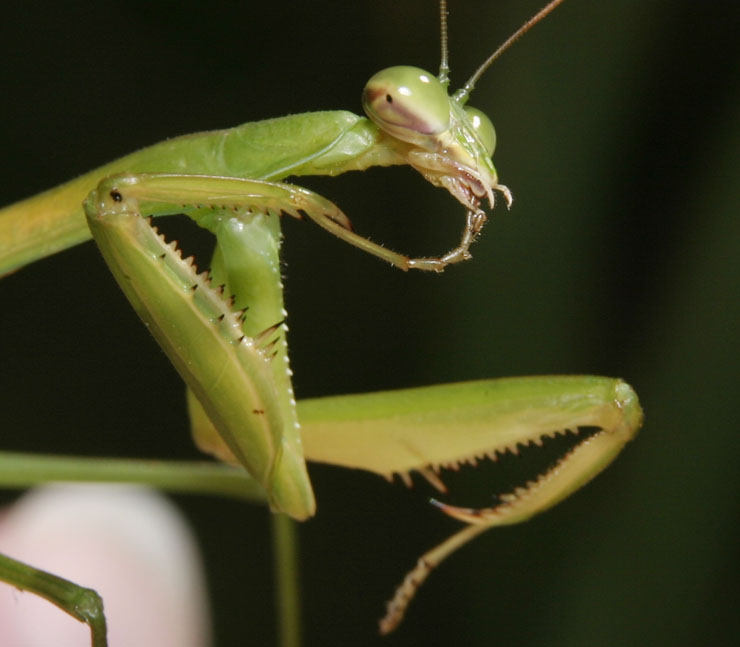
Phil Plait over at Bad Astronomy, in recognition of Caturday, posted a photo of one of his icks, so I had to throw up (heh!) this recent photo that I took.
I’ve never had an issue with mantises, and can usually handle them without too much difficulty. This one stopped for a quick brush-up while wandering on The Girlfriend’s hand – the pink form you see at lower left is her thumb (so don’t say I’ve never included a photo of her.) The fun part about mantises are their eyes – the black dot, while appearing to be a pupil to us because we expect one, is not anything of the sort, since praying mantises have compound eyes and see in many directions at once – both The Girlfriend and I are clearly in sight to the mantis in this photo. Instead, the black dot is a diffraction effect, and I think it actually indicates the part of the eye that is most flat to the observer. I’m trying to determine this for sure right now, but haven’t had it confirmed yet. This leads to lots of speculation that it’s a specific “eye” trait, like those displayed by some butterflies and caterpillars, that makes predators of mantises feel they are facing something dangerous – well, more dangerous, like an owl or snake, but seriously, do mantises need it? They seem to be quite capable of handling themselves.
I originally wondered about it disguising the reflection from the sun, thus avoiding cluing in a potential meal with the shine that plant leaves typically don’t have, but this doesn’t fit, since the surface that reflects sunlight is not usually the one closest to you, but at an angle between you and the sun. As seen here, both the sun and my flash throw their own white spots on the eyes. I’ll have to see what I can determine.
I always considered it “preying” mantis, by the way, but it seems this is not usually the case – it’s the shape of the forelegs, not the ability to eat any damn thing that moves, that provides the name. I have bigger issues with spiders, myself, something it’s taken me a while to reduce, and it’s not fully gone yet. The big ones won’t be perched on my hands (or The Girlfriend’s) for a photo anytime soon.




















































I don’t think it’s a diffraction effect; I think it’s just straight geometric optics. The black dot is where the ommatidia, the components of the compound eye, are oriented such that you’re looking straight down into them. Which means that those are also the particular ommatidia that are looking at you.
The ommatidia have to be very optically directional, taking in light only from a small range of directions, because that’s how each manages to capture a pixel of information from a small angular part of the scene. But that directionality works both ways.
Ahhh, cool! I need to look into this (heh!) more.
Mantises are the only insects I’ve ever seen this from, but I will admit it might only be because their eyes are usually much paler than other insects’. I’ve also noticed that the facets of their eyes seem to be much smaller and flatter, as opposed to others which seem to have a rounded effect to each facet, like a lens. Do you know if this is part of what distinguishes mantis eyesight from some other species?
Great photo. Excellent. :-)